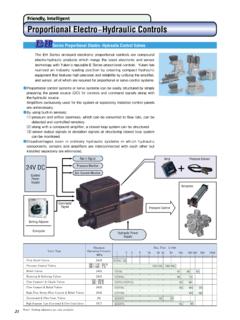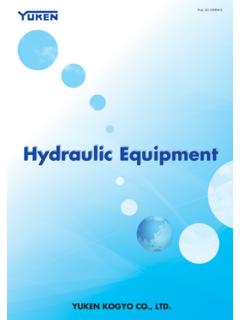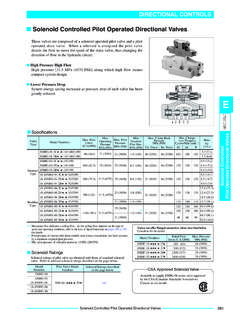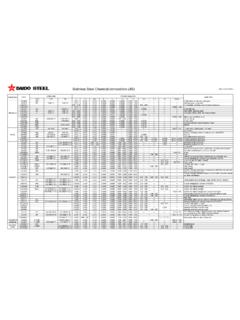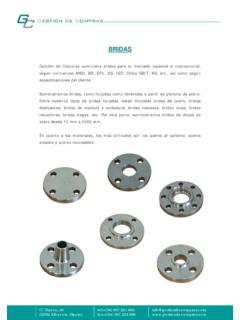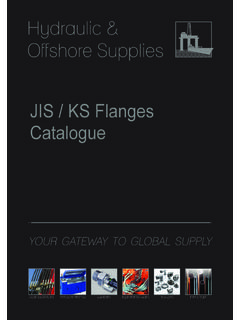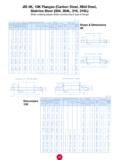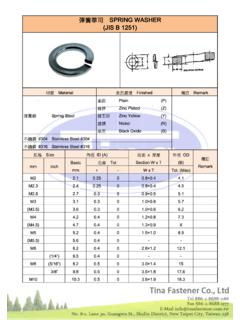Transcription of DATA SHEET - 油研工業株式会社
1 853 data SHEET Hydraulic 854 Part 1: Requirements, Classification, and Properties Part 2: Viscosity and Contamination Control Part 3: Service Limit and Contamination Measuring Instrument Part 4: YUKEN s Hydraulic Equipment and Fluid Types (1) Part 5: YUKEN s Hydraulic Equipment and Fluid Types (2) 859 Part 1: (1) Formulas (1. Pump Output, 2. Shaft Input, 3. Volumetric Efficiency, 4. Overall Efficiency, etc.) Part 2: (1) Cylinder Speed, (2) Cylinder Pressure Part 3: (1) Pipe Size/Flow Velocity, (2) Steel Pipes/Tubes Part 4: (1) Viscosity vs. Temperature, (2) Viscosity Conversion Chart O-Ring 863 Part 1: JIS B 2401 Part 2: AS 568 (Former ARP 568), Aerospace Size Standard for O-Rings International System of Units (SI)..P. 865 - P. 868 data Sheet854 Hydraulic Fluid [Part 1] Requirements, Classification, and Properties data SHEET Requirements Hydraulic pumps, control valves, and hydraulic cylinders operate at high pressure and high speed; they are also constructed of a variety of materials.
2 Considering these facts as well as fluid temperature and ambient conditions during operation, the following requirements for hydraulic fluids must be met. Maintaining proper viscosity as temperature Highly oxidation stable Rust-preventive changes Highly shear stable Non-compressible Flowable at low temperature Non-corrosive to metal Providing good defoaming Resistant to high temperature degradation Exhibiting good demulsibility/water performance Providing high lubricity and wear resistance separation when mixed with water Fire-resistant 40 Classification JIS standards for hydraulic fluids do not currently exist, and fluids that meet the above requirements and have a viscosity equivalent to that of petroleum based turbine oils (JIS K 2213) are used. Turbine oils are classified into two types: Type 1 (without additives) and Type 2 (with additives).
3 Type 2 turbine oils contain antirust, antioxidant, and other additives. JIS K 2213 Type 2 turbine oils and special oils with a viscosity grade of ISO VG 32, 46, or 68 are widely used. If there is a risk of fire in the event of fluid leakage or blowout from hydraulic systems, fire-resistant synthetic or water containing fluids are employed. These fire-resistant fluids have different properties from petroleum base oils and must be handled carefully in practical applications. Chlorinated hydrocarbon fluids are rarely used for industrial purposes in Japan, since they become highly toxic and corrosive when decomposed. While other fluids are also available, fluids used for general industrial purposes are largely categorized as follows. Properties (Example) Petroleum Base Oil (Type 2 Turbine Oil Equivalent to ISO VG 32) Phosphate Ester Fluid Polyol Ester Fluid Water-Glycol Fluid W/O Emulsion O/W Emulsion Specific Gravity (15/4 C) - Viscosity (mm2/s) 40 C 100 C - - Viscosity Index (VI) 100 20 160 146 140 - Max.
4 Operating Temp. ( C) 70 100 100 50 50 50 Min. Operating Temp. ( C) -10 -20 -5 -30 0 0 Strainer Resistance - (Same As Water) Hydraulic Fluid Item Water-In-Oil (W/O) Emulsion High Viscosity Index Hydraulic Oil Low Temperature Hydraulic Oil High Temperature Hydraulic Oil Hydraulic FluidPetroleum Base Oil Synthetic FluidWater Containing Fluid(Fire-Resistant)R&O Type Oil Additive Turbine OilSpecial Oil Phosphate Ester Fluid Polyol Ester Fluid Chlorinated Hydrocarbon Fluid Water-Glycol Fluid Oil-In-Water (O/W) Emulsion Anti-Wear Type Hydraulic Oil (Fire-Resistant) data Sheet855 data SHEET Hydraulic Fluid [Part 2] Viscosity and Contamination Control data SHEET Viscosity The viscosity of industrial lubricants, including hydraulic fluids, is measured by kinematic viscosity v [m2/s], which is obtained by dividing absolute viscosity by density.
5 It is typically expressed in units of square millimeters per second (mm2/s). For viscosity measurement, a capillary viscometer is used to determine kinematic viscosity (mm2/s) as per JIS K 2283 Crude petroleum and petroleum products - Determination of kinematic viscosity and calculation of viscosity index from kinematic viscosity . Hydraulic fluid viscosity critically affects the performance of hydraulic systems. System operation with a hydraulic fluid viscosity outside the specified range may result in pump suction failure, internal leakage, poor lubrication, valve malfunction, or heat generation in the circuit, shortening the life of equipment or causing a major accident. According to JIS K 2001 Industrial liquid lubricants - ISO viscosity classification , 20 viscosity grades are available ranging from ISO VG 2 to 3200. The figure below shows the viscosity range associated with the operation of hydraulic systems.
6 For details, see Viscosity vs. Temperature on page 862. Kinematic Viscosity [mm2/s] For JIS K 2213 Type 2 (with additives), three grades ISO VG 32, 46, and 68 are available. Contamination control Cleanliness Hydraulic fluid replacement is required in the following three cases. (a) Deterioration or degradation of the fluid (b) Particulate contamination of the fluid (c) Water contamination of the fluid While Table 3 provides guidelines for (a), the necessity of hydraulic fluid replacement is caused by (b) and (c) in most contamination of hydraulic fluids may result in pump wear or valve malfunction. In particular, the performance of systems equipped with precision valves ( electro-hydraulic servo valves) and actuators is adversely affected by fine particles of a few micrometers to a few tens of micrometers. Thus, it is necessary to control the level of contamination properly by measuring the size and number of particles in the fluid with a microscope or by measuring the mass of particles per unit volume of the fluid.
7 For the determination of the fluid cleanliness level, filter 100 ml of the fluid through a filtration device and collect particles on a millipore filter (a filter with fine pores of 1/1000 mm). Measure the number and size of the collected particles for classification as shown in Table 1. For highly contaminated fluids, determine the cleanliness level based on the mass of particles collected on the millipore filter, as shown in Table 2. Unused R&O type oils have a cleanliness level of Class 6 to 8 shown in Table 1. Table 1 NAS Cleanliness Level Based on Particle Counting Number of particles per 100 ml Class (NAS 1638) Size ( m) 00 0 1 2 3 4 5 6 7 8 9 10 11 12 5 - 15 125 250 500 1,000 2,000 4,0008,00016,00032,00064,000128,000 256,000 512,0001,024,00015 - 25 22 44 89 178 356 712 1,4252,8505,70011,40022,800 45,600 91,000182,40025 - 50 4 8 16 32 63 126 253 506 1,0122,0254,050 8,100 16,20032,40050 - 100 1 2 3 6 11 22 45 90 180 360 720 1,440 2,8805,760 More than 100 0 0 1 1 2 4 8 16 32 64 128 256 512 1,024 NAS.
8 National Aerospace Standard ISO: International Organization for Standardization Table 2 Classification Based on the Gravimetric Method Class 100 101 102 103 104 105 106 107 108 NAS mg/100 ml Class A B C D E F G H I MIL mg/100 ml Less than - - - - - - - - MIL: Military Specifications and Standards Hydraulic Fluid Viscosity Range (at 40 C) ISO Viscosity Grade (ISO VG) data Sheet856 Hydraulic Fluid [Part 3] Service Limit and Contamination Measuring Instrument data SHEET Service limit Unused R&O type oils contain 50 to 80 ppm ( to ) of water, but the water content increases due to entry of atmospheric moisture through the actuator or air breather. Water may cause rust on the inside of hydraulic equipment, poor lubrication, or accelerated degradation of the hydraulic fluid.
9 The water content of the fluid is measured by Karl Fischer titration (based on the quantitative reaction of the reagent with water) with a sensitivity of 10 ppm. The particulate/water contamination tolerance of hydraulic fluids varies depending on the system configuration as outlined in Tables 4 and 5. Table 4 Recommended Control Level of Fluid Contamination Class System Configuration JIS B 9933(ISO 4406)NAS System with Servo Valve 18/16/137 System with Piston Pump 20/18/149 System with Proportional Electro-Hydraulic Control Valve 20/18/149 System Operating at Pressures Higher than 21 MPa 20/18/149 System Operating at Pressures of 14 to 21 MPa 21/19/1510 General Low Pressure Hydraulic System 21/20/1611 Table 3 Criteria for Hydraulic Fluid Replacement (Example)Petroleum Base Oil Fluid TypeTe s t I t e m R&O Anti-Wear Water-Glycol Fluid Kinematic Viscosity (40 C) mm2/s 10% 10% a To t a l A c i d Number mgKOH/g 40% - : Variation in kinematic viscosity : Additive type (a: Non-zinc based, b: Zinc based) Table 3 provides guidelines for hydraulic fluid replacement.
10 Detailed specifications vary depending on the manufacturer, and additional control requirements may be applied. Contacting the fluid manufacturer is recommended. For example, the total acid number (or acid number) is a measure of fluid degradation and affected by the additive type and level. For water-glycol fluids, the pH value is also controlled. Comparison of JIS B 9933 (ISO 4406) and NAS for reference Table 5 Water Contamination Tolerance of R&O Type Oils 1 ppm = 1/1000000 System Conditions Service Limit The hydraulic fluid is cloudy with water. To be immediately replaced The system has a circuit for circulating the hydraulic fluid back to the oil tank and operates without long-term shutdown. 500 ppm The piping length of the system is long, and the hydraulic fluid does not fully circulate in the circuit. 300 ppm The system remains out of service for a long period (safety system), has a circuit in which the hydraulic fluid hardly moves, or is designed to provide precision control.
